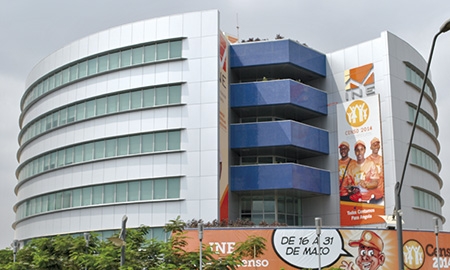Camilo Ceita is a proud and happy man these days and he has every right to be. After years of hard work the organization of which he is General Director, Angola’s National Statistics Institute (
INE) has just successfully completed the country’s first post-independence, nationwide census.
“We achieved 99% coverage rate” for the census, Mr. Ceita proclaimed at the end of the task which was carried out in May with 150,000 people involved including census takers, field staff, technicians and others who managed to question residents in the biggest cities and the remotest areas of this huge country.
Some staff even traveled by river during the operation said to be the largest statistical collection in Angola’s history to make sure each and every resident was counted.
“We are positive that our methodology is in line with that prescribed by the United Nations (UN) and we prepared for it very carefully by carrying out a test census the year before under the same conditions,” he says.
Prior to the census, INE officials flew to New York City to present their methodology to UN experts who praised the Angolan effort that received financial support from the United Nations Population Fund.
Angolan census officials also visited their counterparts in Portugal, Brazil, South Africa, Mozambique and Cape Verde to learn from their experiences.
A PROGRESS MONITOR AND PLANNING TOOLIn spreading the word to its own citizens about the impending national head count, the INE mounted a major publicity campaign using outdoor advertising, comic strips, theater productions and a call center to field questions from citizens in the country’s eight languages.
“The census will be the source of information on almost all we can say about our country and the basis for government planning for the entire nation,” Mr. Ceita explains. “The private investor will also benefit from this information as it will help define the most interesting segments of the entire Angolan market.”
“Any government, any investor and even any academic researcher needs tangible information that must come from credible sources such as national statistics institutes like ours”
CAMILO CEITA
General Director of INE
|
According to the General Director, the census is only the latest of the INE’s constant monitoring of national data which he says clearly shows just how much progress the country has made since the end of the civil war twelve years ago. “Once peace was achieved, the government used income from the country’s mineral resources to create the conditions so Angola could move forward,” he recalls.
“Within a few years, the refugee problem was largely solved, vital infrastructure like roads, schools, hospitals and housing were built and the country began to catch up.”
Foreign investors took note and soon companies from around the world were active in Angola and assisting in its economic and social development. Rising prices for oil, the country’s main foreign exchange earner by far, financed the economic boom which lifted many citizens out of poverty and into the middle class.
New jobs and new opportunities sprang up, creating further prosperity and demand rocketed for consumer goods and other tangibles which local and foreign suppliers were only too happy to provide.
“We, of course, measure economic data like foreign trade, industrial production, income levels and other vital statistics and we have records showing that poverty rates fell by half between 2001 and 2009,” says Mr. Ceita.
Other statistics gathered by the INE demonstrated improvement in a number of other areas such as an increase in the number of children attending school and a dramatic rise in the government provision of basic health care.
“Any government, any investor and even any academic researcher needs tangible information that must come from credible sources such as national statistics institutes like ours,” the general director argues.
“Obviously there are companies that carry out their own studies but our role and our major challenge is to report on the past, know about the present and project the future.”
GETTING DOWN TO SPECIFICSINE also produces special reports available on request such as a recent table of statistics on bilateral trade between the United States and Angola for the U.S. Embassy.
Currently, INE representatives are working in every province of the country to collect economic information like prices, job numbers and other data by canvassing companies, families and individuals.
“With this information we could, for example, track prices and inflation in Luanda and other parts of the country,” the General Director says. “Soon we are going to be able to produce the national accounts annually with updates every three months to complement the government’s estimates.”
INE officials are also working on producing reports that will explore six key sectors of the economy such as trade, agriculture, transport and manufacturing to define market needs that will aid investors in planning their operations.
“In other words, we are concentrating all our efforts so that the whole population can have access to the information we produce,” he explains.
But at the moment, Mr. Ceita and his team are busy compiling all the information garnered during the census so it can be publically released on time. “According to international standards, it takes any country 18 months to deliver census results and we plan to release preliminary results such as gender data in three months,” says Mr. Ceita.
In describing his job, the general director says he sometimes feels like both a soccer coach and a player at the same time.
“I have to oversee all the activity and contribute as an individual as well. I bear the greatest responsibility if the results are good or bad. This is what I have to handle.”

0 COMMENTS